

37 maps that explain the American Civil War. Civil War. Battles of Chickamauga and Chattanooga. Sherpa Guides > Civil War > Sidebars > The Battles of Chickamauga and Chattanooga The Battles of Chickamauga and Chattanooga Chickamauga was the biggest battle fought in the Western Theater, and the bloodiest, with more than 34,000 casualties.
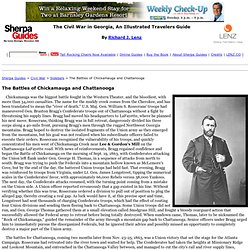
The name for the muddy creek comes from the Cherokee, and has been translated to mean the "river of death. " U.S. Maj. The battles for Chattanooga, coming two months later from Nov. 23-25, 1863, was a Union victory that set the stage for the Atlanta Campaign. D position of the Confederates. . [ Previous Topic | Next Topic ] Read and add comments about this page Reader-Contributed Links to the Civil War in Georgia Book: [an error occurred while processing this directive]
Civil War Battles & Civil War Casualties Interactive Map. Civil War 150 — History.com Interactive Games, Maps and Timelines. The Civil War. The Civil War as Photographed by Mathew Brady. Background Many historians call the Civil War the central event in U.S. history.
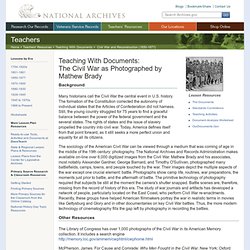
Civil War Photographs: The Mathew Brady Bunch - Lesson Plans. Back to Lesson Plans Lesson Overview The Civil War was the first American war thoroughly caught on film.

Mathew Brady and his crew of photographers captured many images of this divisive war, ranging from portraits to battle scenes. These photographs--over 1,000--are in Selected Civil War Photographs 1861-1865 in American Memory. Students become reporters, assigned to sort through these photographs and find one that will bring the war alive to their readers. Objectives After completing this unit students will be able to: Primary Source Sets - For Teachers. Teachers.
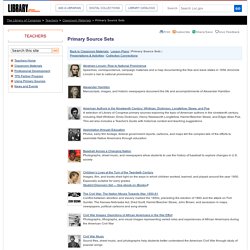
American Slave Narratives. From 1936 to 1938, over 2,300 former slaves from across the American South were interviewed by writers and journalists under the aegis of the Works Progress Administration.
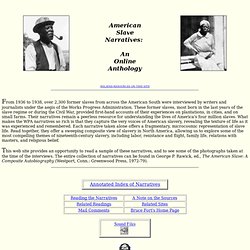
These former slaves, most born in the last years of the slave regime or during the Civil War, provided first-hand accounts of their experiences on plantations, in cities, and on small farms. Their narratives remain a peerless resource for understanding the lives of America's four million slaves. What makes the WPA narratives so rich is that they capture the very voices of American slavery, revealing the texture of life as it was experienced and remembered.
Each narrative taken alone offers a fragmentary, microcosmic representation of slave life. Read together, they offer a sweeping composite view of slavery in North America, allowing us to explore some of the most compelling themes of nineteenth-century slavery, including labor, resistance and flight, family life, relations with masters, and religious belief. From Revolution to Reconstruction: Outlines: Outline of American Literature. 3. A Southern World View: The Old South and Proslavery Ideology. 3D American Civil War on Google Earth. Getting the Civil War Right. Printer-friendly version William Faulkner famously wrote, “The past is never dead.

It’s not even past.” He would not be surprised to learn that Americans, 150 years after the Civil War began, are still getting it wrong. During the last five years, I’ve asked several thousand teachers for the main reason the South seceded. They always come up with four alternatives: states’ rights, slavery, tariffs and taxes or the election of Lincoln. When I ask them to vote, the results—and resulting discussions— convince me that no part of our history gets more mythologized than the Civil War, beginning with secession. My informal polls show that 55 to 75 percent of teachers—regardless of region or race—cite states’ rights as the key reason southern states seceded. These results are alarming because they are essentially wrong.
The issue is critically important for teachers to see clearly. The Gettysburg Address Animated. Gettysburg Address history: Why "four score and seven years ago"? Tuesday marks the 150th anniversary of Lincoln’s Gettysburg Address.
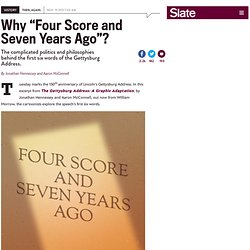
In this excerpt from The Gettysburg Address: A Graphic Adaptation, by Jonathan Hennessey and Aaron McConnell, out now from William Morrow, the cartoonists explore the speech’s first six words. Excerpted from The Gettysburg Address: A Graphic Adaptation, by Jonathan Hennessey and Aaron McConnell, out now from William Morrow. Correction, Nov. 19, 2013: A panel in this excerpt misstated that the Hartford Convention of 1814-15 occurred during Thomas Jefferson’s presidency.
It occurred during James Madison’s presidency. Civil War Image Map/Battle Maps. Jackson's Valley Campaign.